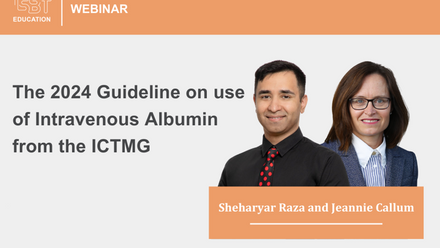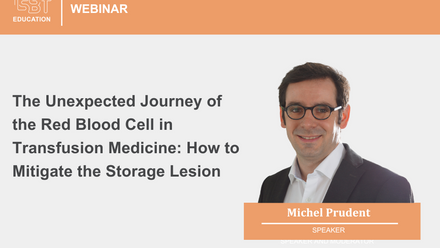The Platelets.... but not as we know them session included the following presentations:
1. Denese Marks: New Platelet Products (Cold stored, cryopreserved, thrombosomes)
2. Johanna Kirschall: Inhibition of cold-induced apoptosis of platelet concentrates better maintains platelet functionality and survival
3. Mohammad Reza Deyhim: The effect of N-acethyl cysteine (NAC) on expression of apoptotic and antiapoptotic microRNAs in platelet concentrates during storage
4. Lucia Merolle: Membrane Molecular Changes Associated with Platelet Cryopreservation
5. Kristina Ehn: Cryopreserved platelets in a novel non-toxic DMSO-free setting maintain hemostatic function in vitro
MODERATORS: Sandra Pettersson and Stephen Thomas
After the presentation, there was a questions and answers session, which is also included in the recording.
Abstract
Membrane molecular changes associated with platelet cryopreservation
L Merolle1, G Gavioli2, A Razzoli2, D Bedolla3, B Iotti1, G Birarda3, L Vaccari3, D Schiroli1, C Marraccini1, R Baricchi1
1Transfusion Medicine Unit, AUSL-IRCCS di Reggio Emilia, Reggio Emilia, 2PhD Program in Clinical and Experimental Medicine, University of Modena and Reggio Emilia, Modena, 3SISSI-beamline, Elettra – Sincrotrone Trieste S.C.p.A., Trieste, Italy
Background: It is well known that cryopreservation affects platelet quality and function by triggering platelet activation or apoptosis, thereby inducing the release of platelet extracellular vescicles (PEVs). The concept of plasma membrane blebbing leading to the shedding of PEVs is based on a transverse migration of anionic phospholipids such as Phosphatidilserine (PS) from the inner layer to the outer layer of the plasma membrane (Antwi-Baffour et al., 2015). Nevertheless, the biochemical events occurring in the plasma membrane over time after thawing concurring to these phenomena have still not been well investigated.
Aims: The present study aim (i) to evaluate the influence of cryopreservation on membrane phospholipids and protein folding; (ii) to elucidate the roles of molecular structure and conformation in damage to cryopreserved platelets over time after thawing leading to PS exposure and PEVs release.
Methods: We performed a comparative study between fresh-(T0) (n = 5), either unstimulated or stimulated with physiological agonist (Thrombin 62 mU/mL), and cryopreserved (n = 5) platelet-apheresis units. Fresh components were collected in plasma, analysed within 5 days from collection, whereas cryo-platelets were thawed after 6 months, and analysed at 1, 3 and 6 h after reconstitution in platelet additive solution. Phosphatidylserine externalization and PEVs release were assessed by means of flow cytometry, whereas FTIR spectroscopy (SISSI-Bio beamline, Elettra Synchrotron) was exploited to evaluate the influence of cryopreservation on membrane phospholipids and protein folding. FTIR data were analysed with a univariate approach by evaluating the ratios between the absorbance of significant peaks to obtain data on membrane stiffness (CH2/CH3 ratio); protein content (protein/lipid ratio); Peroxidation processes CO/lipids and CO/proteins. After that a Principal Component Analysis (PCA) was performed to understand the key grouping variables in the data and spot outliers. ANOVA with multiple comparisons test was performed to assess statistical significance among different samples.
Results: Our data showed an increase of PEVs in cryopreserved units with a 38-fold increase of EV concentration after 1 h from thawing with respect to the fresh unstimulated samples (overall ANOVA p < 0.05). In accordance, 1 h thawed samples presented an increase of PS signal compared to fresh components (36.5 ± 4.2 vs. 77.0 ± 8.4%, p < 0.0001). Although the difference with fresh samples was still statistically significant, this increase tended to be reduced over time after thawing (3 and 6 h). Similar to PS exposure, PEVs release decreased over time. CH2/CH3 ratio increased as the time after the thawing grows; T0, 1 h and 3 h values are significantly different, whereas 3 and 6 h are not. Protein/lipid ration indicate a loss of protein whereas both CO/lipids and CO/proteins increase in time after thawing; again 3 and 6 h are no longer discriminable. Finally, PCA revealed an overlap of fresh and 1 h samples that can be assigned to proteins in α-helix conformation while data at 3 and 6 h after thawing are separated from those at T0 and 1 h and can be assigned to proteins in β-sheet conformation, (higher in samples at 3 and 6 h).
Summary/Conclusions: The data herein reported demonstrates how time after thawing affects membranes' functional characteristics and integrity. The decreases in PS-positive platelet counts and of the EVs release over time after thawing mirrors the increased peroxidation process and misfolding of phospholipid bilayer proteins seen by FTIR analysis and account for the alteration of membrane integrity and stiffness, which occur irreversibly 3 h after thawing.






